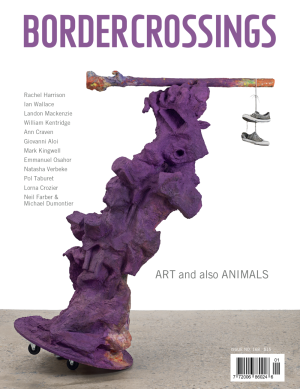Lorraine Simms
The relationship between painting and technology is growing ever tighter, and yet more fluid in the recent work of Montreal painter Lorraine Simms. Her 2002 exhibitions in Montreal and Saint-Hyacinthe introduced many of the themes that continue to inspire her. Images of something going on—rescue operations, crowds milling, innocent bystanders, petty criminals and their dusky natural habitats—these things form the content of her work. Simms collects pictures from newspapers, television and the Internet, paying particular attention to the extras and bit players in newsworthy events. Photojournalist Robert Capa’s oft-cited mantra—if your pictures aren’t good enough, you’re not close enough—seems to counter-inform Simms’s vision, by which I mean that she goes for the not-good-enough pictures, knowing that most of us spend our lives outside the yellow tape, speculating lamely about the dramas taking place inside. That is, if we’re lucky.
Simms’s source pictures fascinate critic Jim Drobnick, whose essay accompanies Simms’s new body of work, “The Real Imaginary,” shown this spring at Sylviane Poirier art contemporain in Montreal. Drobnick writes: “Surveillance images often harbour elements of shock or menace; in Simms’s practice, their status as visual and epistemological enigmas is foregrounded.” Simms explains the content of her work as a mediated transmission of knowledge that is systematically inadequate. Her adoption of these embryonic images and stunted narratives is the first step toward a painting. What interests her audience is where she goes next.

Lorraine Simms, Thief (Elastic Moment), 2004, oil on canvas, 40 x 54”. Photographs courtesy the artist.
There are three groups of work in “The Real Imaginary”: medium-scale oil paintings on canvas; small tondos, oil on linen; and a series of portraits, oil on paper. Except for the last group, each of which must be done in a single sitting, these works are the result of slow processes, much reconsideration. Translucent layers of paint preserve the light that is, of course, true to the genesis of these images. The colour is another story. Simms’s colour is, in one sense, restrained, since the information fields seem almost monochromatic, but it is also brash, in the sense that it dominates and twists emotionally what it purports neutrally to convey. And then there are those bands and amorphous shapes, those non-information fields, through which we enter the work and discover its pictorial structure. Where do we think we are going? The signposting is not reassuring. Simms is captivated by the blurs and distortions of everyday photo-life. We can read her paintings, if that’s what we feel we have to do, through the peculiar logic of the lens.
The tondos are reminders of the instruments through which we view the world, but they are much more than that. Take them as the feminine spaces of painting in which we have encountered madonnas and babes; take them as a shape that nurtures life and postpones certainty. For the situations that interest Simms are developing. In one, a crowd is running; in another, a spotlight burns bright at the core; and over there, a uniformed figure is setting up a flare. One greenish space, animated by light vertical shapes (trees?), invaded by soft bowing forms (curtains?), half-defined by a rustic fence (neighbours?), urges us to peer through some passage into the dark. The mood is eerie, but manageably so, because the circle reminds us of the fiction.

Lorraine Simms, Thief (Ghost), 2004, oil on canvas, 40 x 54”.
The portraits are equally ambiguous. Simms calls the series “Journal,” which in bilingual Montreal means both daily newspaper and diary. The piece conflates obJective reportage—a head shot—with a painter’s productive ruminations. The pictures are cut out from the papers—Simms reads the story to be sure—but then the pictures hang around, they are occasionally sifted until one somehow fits her mood, her desire to work with a particular colour, and then the portrait is made. Evocative of something other than the facts, they are nevertheless startling in their immediacy and specificity, and this is odd, because names and circumstances have mostly been lost along the way. In the late 1990s, Simms made a series of self-portraits that come from the same psychological space. Now she is wearing the masks of others.
If there is a social comment in this work, and people seem to expect one from media-based mediations, it is that we take from these images what we want, what we need, for our own purposes. If fear fits our world view, we turn on for the frisson, and we find it. If perception and its service to memory is what intrigues, Simms’s work takes you there, because she has surrendered herself so completely to the process. But if a story is what you want, this one turns around a central character who is a painter in the real world, relating to her surroundings not as a source of images, but as images that she translates directly to canvas, linen or paper. Pick someone’s pocket, or win the lottery, get your mug-shot in the paper, and you are likely to turn up in Simms’s work. You are anonymous now, your head is an expressive arrangement of planes, strokes and delicate lines that attest to the fact of your existence in Simms’s mind. You matter, as visual matter. ■
“Lorraine Simms: The Real Imaginary” exhibited at Sylviane Poirier art contemporain in Montreal from May 1 to 29, 2004.
Martha Langford, contributing editor for Border Crossings, has been appointed as Artistic Director for Le Mois de la Photo à Montréal, 2005.

